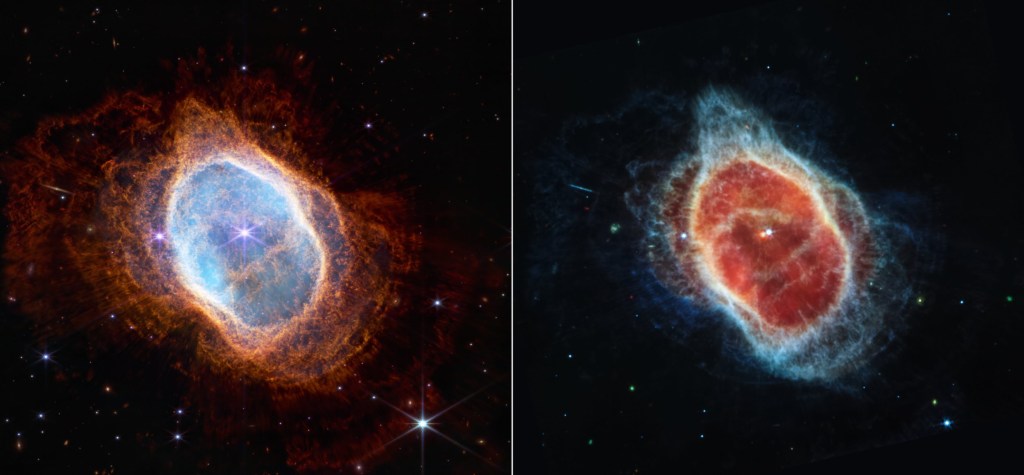(CNN) --
NASA will reveal live Tuesday the first high-resolution, color images from the James Webb Space Telescope, showing the universe as you've never seen it before.
From a stellar nursery where stars are born, to the interactions between galaxies and the unique perspective of an exoplanet: these are just some of the new cosmic images that will be shared.
President Biden Reveals First James Webb Space Telescope Image
After waiting for decades, it is finally time for the world to see the first images of the most powerful space telescope in history: the James Webb.
Development of this space observatory began in 2004. And, after years of delays, the telescope and its huge golden mirror were finally launched on December 25.
This is the deepest infrared image of the universe ever captured.
The photograph achieved by the James Webb Space Telescope was presented on Monday by President Joe Biden.
The images are worth the wait: they will forever change the way we see the universe.
Bill Nelson, the administrator of NASA, wrote that Webb will give humanity a new view of space and fundamentally alter our understanding of the universe.
The "deepest image of our universe" ever taken by the Webb telescope will be revealed in July
"These images show the power of Webb in searching for signs of life and habitability on other worlds. Its extreme sensitivity will help scientists understand some of the big questions about how and why stars form. It will also bring clarity to stars and galaxies in a way we've never seen before. From star formation to devouring black holes, this telescope will reveal all this and more," he said.
The first image gives a glimpse of the deep universe
This Monday, President Joe Biden revealed one of the first images of Webb.
It is "the deepest and sharpest infrared image of the distant universe to date," according to NASA.
The photograph shows SMACS 0723, where a massive group of galaxy clusters works like a magnifying glass for objects behind them.
Called gravitational lensing, this created Webb's first deep-field glimpse of incredibly old and faint galaxies.
advertising
Some of these distant galaxies and star clusters have never been seen before.
The galaxy cluster is shown as it appeared 4.6 billion years ago.
The image, taken by Webb's near-infrared camera, is made up of pictures taken in different wavelengths of light over a total of 12.5 hours.
Deep field observations are extended observations of regions of the sky that can reveal faint objects.
A dying star, the second image from the James Webb Telescope
Two cameras from the Webb Space Telescope captured the latest image of this planetary nebula, called NGC 3132 but informally known as the South Ring Nebula or "Eight Bangs," which is approximately 2,500 light-years away, according to NASA.
The agency explained that "the fainter star at the center of this scene has sent out rings of gas and dust for thousands of years in all directions, and the Webb telescope revealed for the first time that this star is covered in dust."
In this sense, NASA pointed out that Webb will allow us to delve into much more detail about planetary nebulae like this one: "clouds of gas and dust expelled by dying stars."
And "understanding which molecules are present and where they are found in the gas and dust layers will help researchers refine their knowledge of these objects."
Stephan's Quintet, other images
The telescope's view of Stephan's Quintet will help reveal how galaxies interact with each other.
This compact group of galaxies, first discovered in 1787, lies 290 million light-years away in the constellation Pegasus.
Four of the five galaxies in the group "are locked in a cosmic dance of repeated close encounters," according to a NASA statement.
This huge mosaic is Webb's largest image to date and covers about a fifth of the Moon's diameter, the agency said.
"It contains more than 150 million pixels and is constructed from nearly 1,000 separate image files. Webb's information provides new insights into how galactic interactions may have driven the evolution of galaxies in the early universe," he said.
Webb's infrared vision and extremely high spatial resolution allowed it to capture details never before seen in this group of galaxies, NASA said.
"Bright clusters of millions of young stars and starburst regions of fresh star birth adorn the image.
Stephan's Quintet, a visual grouping of five galaxies, is best known for being featured prominently in the classic Christmas movie, "It's a Wonderful Life."
Today, NASA's James Webb Space Telescope reveals Stephan's Quintet in a new light.
This huge mosaic is Webb's largest image to date and covers about a fifth of the Moon's diameter.
It contains over 150 million pixels and is built from nearly 1,000 separate image files.
Webb's information provides new insights into how galactic interactions may have driven the evolution of galaxies in the early universe.
With its powerful infrared vision and extremely high spatial resolution, Webb shows details never before seen in this group of galaxies.
"Bright clusters of millions of young stars and starburst regions of fresh star birth adorn the image. Tails of gas, dust, and stars are pulled from several of the galaxies due to gravitational interactions. More dramatically, Webb captures huge ripples of collide when one of the galaxies, NGC 7318B, passes through the cluster"
The worlds that NASA's Webb Telescope will open
NASA's telescope can investigate the mysteries of the universe by observing them through infrared light, which is invisible to the human eye.
Webb will observe the atmospheres of exoplanets, some of which are potentially habitable.
He might also uncover clues in the ongoing search for life outside of Earth.
Webb telescope's sharp views of the universe will change astronomy
The observatory will also have glimpses of every phase of cosmic history, including the first afterglows after the Big Bang that created our universe and the formation of the galaxies, stars and planets that make it up today.
Now Webb is ready to help us understand the origins of the universe.
As well as to begin to answer key questions about our existence, for example where we come from and if we are alone in the cosmos.
The mission, initially planned to last 10 years, has enough excess fuel capacity to operate for 20 years, according to NASA Deputy Administrator Pam Melroy.
These will be just the first of many images to come from Webb over the next two decades.
Which promises to fundamentally alter the way we understand the cosmos.
NASAWebb TelescopeUniverse













